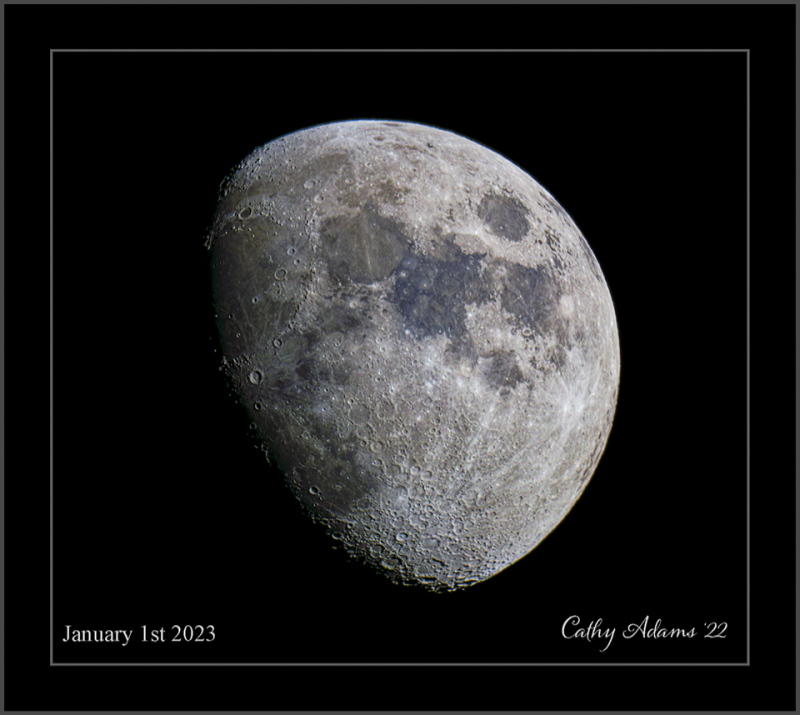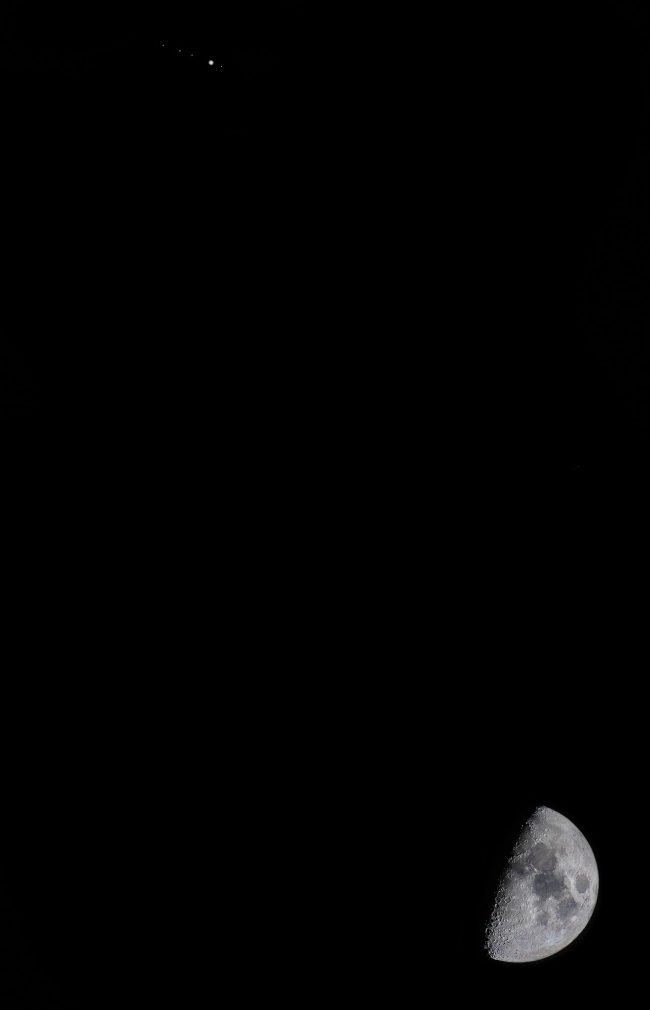
Top 12 brightest objects
What are the brightest natural objects in our solar system? We’re not counting transient objects, such as very bright meteors. And we’re not including human objects, such as satellites and the International Space Station. The sun, our star, is our solar system’s brightest natural object. But you might be surprised by some others that make the list. You can see the first seven objects on this list easily, using just your eyes, even from cities and suburbs. The last few items are fainter and more challenging to view … while still among our solar system’s brightest objects.
Astronomers refer to an object’s brightness by its magnitude. The lower the magnitude number, the brighter the object. So 1st-magnitude objects are the brightest stars in our sky. And 2nd-magnitude objects are fainter, 3rd-magnitude fainter still, and so on.
Note that some objects, such as Venus, are even brighter than 1st magnitude, peaking in negative numbers at their brightest. Read about stellar magnitude here.
Without optical aid, the human eye can see objects to around 6th magnitude, in optimum conditions and under dark skies. There are about a dozen natural solar system objects that are, in theory, visible to the unaided eye. In practice, the fainter ones are very difficult to see with the eye alone, but possible for those keen vision and true darkness. Here are the top 12 brightest natural solar system objects, in order from brightest to dimmest:
1. The sun
No surprise here. The sun shines at magnitude -26.7. Technically, the sun can’t even be looked at without special safety filters to protect your eyes. Gazing at the sun directly without special protective filters can cause blindness.
That said, now would be a good time to equip yourself with filters for solar observing, and to begin a program of regular sun viewing. You might know that the sun increases and decreases in activity in a cycle lasting 11 years. Experts announced the new cycle – Solar Cycle 25 – in September 2020. The peak of the cycle is expected for around 2025. You can get an update on the sun’s activity every day from the EarthSky’s sun team.
Read more: Top 7 tips for observing the sun safely
Read more: Daily updates on sun activity here
2. The moon
The moon varies in brightness depending on what phase it’s in. At its full phase when it’s the brightest, it tops out at magnitude -12.7. On the other hand, the moon in its crescent phase shines at only about magnitude -6.
If you’re a deep-sky observer, the moon is bright enough to ruin your night vision, meaning it’ll prevent you from getting the best view of distant, faint star clusters, nebulae and galaxies. If you’re using a telescope, the moon should be your last stop during a night of observing. To the eye alone, though, there’s nothing more beautiful than a bright moon shining in the night sky, casting its light and creating moon shadows in the landscape all around you. Pick up a moon phases calendar to keep track of the moon’s nightly show.

3. Venus
The closest planet to Earth, one step inward in orbit around the sun, is also the brightest planet. It can shine as brightly as magnitude -4.7, bright enough to be seen in daylight if you know just where to look. The brightness of Venus is thanks in part to its proximity to Earth and also, largely, to its thick, reflective clouds.
As with all the other solar system objects, Venus varies in brightness depending on a number of factors, including how close it is to Earth and what phase it’s in. Yes, as a planet orbiting inward from Earth, Venus shows phases! Find Venus’ current location in EarthSky’s night sky guide.
4. Mars
The red planet is the 2nd-closest planet to Earth after Venus, and it reaches its maximum magnitude of -2.9 approximately every two years. This is when Mars reaches opposition, or opposite the sun in Earth’s sky. The red planet’s most recent opposition was on December 8, 2022. So it’s still bright, but fading from here on out.
So, sometimes Mars is faint, such as when it’s on the far side of the solar system from us. Then, it shines across its nearly-maximum distance from Earth (about 250 million miles, or 400 million km). After all, Mars is just a little planet, smaller than Earth. Its brightness waxes and wanes dramatically as we and Mars move around the sun. Find Mars’ location for each month in EarthSky’s night sky guide.
5. Jupiter
Because Jupiter is the largest planet in the solar system, some mistakenly believe it’s the brightest planet. But not so. Jupiter’s greater distance from us lets Venus and Mars, our neighbors, shine more brightly. Jupiter is nearly always brighter than Mars, though (except when Mars is at its best). At its maximum, Jupiter shines at magnitude -2.8, nearly as bright as Mars’s peak of -2.9, and brighter than Sirius, the sky’s brightest star, which shines at magnitude -1.4.
Jupiter was named for the ancient king of the gods. And it has a king-like aspect, always shining at the same dazzling brightness, not changing in brightness like Mars. Plus Jupiter moves in a stately way around the sky; it isn’t tied to the sunrise or sunset like Venus. Come to know Jupiter, and you’ll enjoy spotting it in your sky for much of every year. Find Jupiter’s location for each month in EarthSky’s night sky guide.
6. Mercury
Surprise! The rarely-seen planet Mercury shines more brightly than Saturn at its best. Mercury can reach -1.9 magnitude. That’s brighter than Sirius, the sky’s brightest star. But – because Mercury is our solar system’s innermost planet – this world, more than any other in our solar system, is tied to the sun in our sky. You can only see it shortly before sunrise or shortly after sunset. Therefore, it never gets very high in the night sky. So its brightness is often offset by the fact that you’re viewing the planet in twilight and not in a nice dark sky. Still, Mercury’s brightness will surprise you!
7. Saturn
The ringed planet Saturn is stunning in a telescope, and it’s also an easy catch without optical aid. With the eye alone, you won’t see its rings, but you will see Saturn’s golden color and steady light. At magnitude +0.7, Saturn outshines most stars and is on a par with most of the brightest stars. Plus – because it orbits our sun beyond Earth’s orbit – casual observers can spot it more often than Mercury. Saturn is often around deep into the night, when its brightness contrasts with the depths of a dark night sky.

8. Jupiter’s moon Ganymede
If you’re a sky-watcher, you’ve probably seen all the objects mentioned so far without optical aid, knowingly or not. But have you seen Jupiter’s largest moon, Ganymede? Binoculars will let you spot Ganymede circling Jupiter when the satellite is at its brightest, approximately 4.6 magnitude. Ganymede takes about seven Earth-days to complete an orbit around Jupiter, and the other Galilean moons take varying amounts of time (Io nearly two days, Europa about four days, Callisto 17 days).
So on any given night, you’ll find the moons in ever-shifting locations with respect to Jupiter. They look like little “stars” strung out in a line that bisects Jupiter. Thus you’ll want to use software, for example SkyandTelescope.com’s interactive Jupiter moon page, to let you know which dot circling Jupiter is Ganymede, from the location, date and time at which you’re looking. Which leads us to …
9. Jupiter’s moon Io
The next item on the solar system brightness list is Jupiter’s volcanic satellite, Io. At a little larger than our moon, Io is the innermost Galilean satellite and shines at magnitude 5.0 when it’s at its best.
Can you see Io – or Ganymede – with the eye alone? In theory, you should be able to. But in practice they’re not that easy to see in the glare from Jupiter itself. Some observers with renowned vision (for example, Steven James O’Meara) have claimed to have seen Ganymede with the unaided eye. But you’ll likely need binoculars for Ganymede or Io, or Europa (see below). Small telescopes show all four Galilean moons in their never-ending dance around Jupiter.

10. Asteroid Vesta
The fourth asteroid discovered, Vesta, is the only asteroid to make our list of brightest solar system objects. Vesta is the 2nd-largest asteroid after Ceres. Vesta can reach magnitude 5.1 at its closest approach to Earth. Its next opposition – a highlight of the year for asteroid observers – is on December 21, 2023.
During Vesta’s opposition, Earth will sweep more or less between Vesta and the sun, bringing the asteroid closest to us for the year. Because Vesta doesn’t have a bright nearby locator, as Ganymede and Io have with Jupiter, it’s best to watch for Vesta for a couple of nights in a row to see which dim “star” in the area appears to move slowly in front of the fixed star background. Visit In-The-Sky.org for more.
11. Jupiter’s moon Europa
We bounce back out to Jupiter for the next item on the list, Europa, another of Jupiter’s four large Galilean moons. Europa is a great object to attempt to view and ruminate on, because it may harbor an ocean – and possibly life – beneath its icy crust. Europa just makes our list of the brightest objects in the solar system at magnitude 5.2. Again, we recommend using observing software, such as SkyandTelescope.com’s interactive Jupiter moon page, to know which Galilean moon is which.
12. Uranus
Finally! Many know that planet Uranus is theoretically visible to the unaided eye. The 7th planet from the sun appears at magnitude 5.6 at its best. Uranus is most easily picked up with the unaided eye after first pinning down its location with binoculars or a telescope. It has a disk instead of a pinpoint image through an optical device and may even appear faintly bluish green. It is particularly easy to find on the occasions that it pairs up closely with objects easier to locate, such as Mars.

Bottom line: Here are the top 12 brightest natural solar system objects, in order from brightest to dimmest. If you’ve seen every one of these objects, with or without optical aid, congrats!
The post Top 12 brightest objects in our solar system first appeared on EarthSky.
0 Commentaires